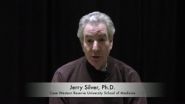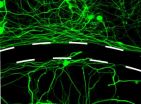(Press-News.org) VIDEO:
NIH-funded scientists developed a promising new drug that may lead to spinal cord injury treatments.
Click here for more information.
Injections of a new drug may partially relieve paralyzing spinal cord injuries, based on indications from a study in rats, which was partly funded by the National Institutes of Health
The results demonstrate how fundamental laboratory research may lead to new therapies.
"We're very excited at the possibility that millions of people could, one day, regain movements lost during spinal cord injuries," said Jerry Silver, Ph.D., professor of neurosciences, Case Western Reserve University School of Medicine, Cleveland, and a senior investigator of the study published in Nature.
Every year, tens of thousands of people are paralyzed by spinal cord injuries. The injuries crush and sever the long axons of spinal cord nerve cells, blocking communication between the brain and the body and resulting in paralysis below the injury.
On a hunch, Bradley Lang, Ph.D., the lead author of the study and a graduate student in Dr. Silver's lab, came up with the idea of designing a drug that would help axons regenerate without having to touch the healing spinal cord, as current treatments may require.
"Originally this was just a side project we brainstormed in the lab," said Dr. Lang.
After spinal cord injury, axons try to cross the injury site and reconnect with other cells but are stymied by scarring that forms after the injury. Previous studies suggested their movements are blocked when the protein tyrosine phosphatase sigma (PTP sigma), an enzyme found in axons, interacts with chondroitin sulfate proteoglycans, a class of sugary proteins that fill the scars.
Dr. Lang and his colleagues designed a drug called ISP to block the enzyme and facilitate the drug's entry into the brain and spinal cord. Injections of the drug under the skin of paralyzed rats near the injury site partially restored axon growth and improved movements and bladder functions.
"There are currently no drug therapies available that improve the very limited natural recovery from spinal cord injuries that patients experience," said Lyn Jakeman, Ph.D., a program director at the NIH's National Institute of Neurological Disorders and Stroke, Bethesda, MD. "This is a great step towards identifying a novel agent for helping people recover."
Initially, the goal of the study was to understand how interactions between PTP sigma and chondroitin sulfate proteoglycans prevent axon growth. Drugs were designed to mimic the shape of a critical part of PTP sigma, called the wedge. Different designs were tested on neurons grown in petri dishes alongside impenetrable barriers of proteoglycans. Treatment with ISP freed axon growth.
"It was amazing. The axons kept growing and growing," said Dr. Silver.
Next the researchers tested the potential of the drug on a rat model of spinal cord injury. For seven weeks they injected rats with the drug or a placebo near the site of injury. A few weeks later the rats that received the drug showed improvements in walking and urinating while the placebo treatments had no effect. The results suggested the drug passed into the brain and spinal cord.
When the researchers looked at the spinal cords under a microscope they found that the drug induced sprouting of axons that use the neurochemical serotonin to communicate. The sprouting axons were seen below the injury site. Treating some rats with a blocker of serotonin communication partially reversed the beneficial effects of ISP injections, suggesting the newly sprouting axons helped the rats recover.
The ISP drug did not cause spinal cord axons known to control movements to cross the scar and reconnect with brain neurons above the injury site. Dr. Silver and his colleagues think this means the ISP-induced sprouting helped the rats recover by increasing the signal sent by the few remaining intact axons.
"This is very promising. We now have an agent that may work alone or in combination with other treatments to improve the lives of many," said Dr. Silver. He and his colleagues are seeking to test the ISP drug in preclinical trials.
INFORMATION:
This work was supported by grants from the NINDS (NS025713), Case Western Reserve University Council to Advance Human Health, Mrs. Suzanne Poon, Unite to Fight Paralysis, The Brumagin Memorial Fund, Spinal Cord Injury Sucks, United Paralysis Foundation and The Kaneko Family Fund.
References:
Lang et al. "Modulation of the proteoglycan receptor PTPσ promotes recovery after spinal cord injury," Nature, December 3, 2014. DOI: 10.1038/nature13974
For more information on brain research, visit:
http://www.ninds.nih.gov/disorders/sci/sci.htm
The NINDS/ is the nation's leading funder of research on the brain and nervous system. The mission of NINDS is to seek fundamental knowledge about the brain and nervous system and to use that knowledge to reduce the burden of neurological disease.
About the National Institutes of Health (NIH): NIH, the nation's medical research agency, includes 27 Institutes and Centers and is a component of the U.S. Department of Health and Human Services. NIH is the primary federal agency conducting and supporting basic, clinical, and translational medical research, and is investigating the causes, treatments, and cures for both common and rare diseases. For more information about NIH and its programs, visit http://www.nih.gov.
Case Western Reserve scientists have developed a new chemical compound that shows extraordinary promise in restoring function lost to spinal cord injury. The compound, which the researchers dubbed intracellular sigma peptide (ISP), allowed paralyzed muscles to activate in more than 80 percent of the animals tested. The remarkable study, partly funded by the National Institutes of Health, appears in the December 3 edition of the journal Nature.
Case Western Reserve University School of Medicine Professor of Neurosciences Jerry Silver, PhD, the senior author, led an international ...
Pilots are trained to guard against vertigo: a sudden loss of the sense of vertical direction that renders them unable to tell "up" from "down" and sometimes even leads to crashes. Coming up out of a subway station can produce similar confusion: For a few moments, you are unsure which way to go, until regaining your sense of direction. In both cases, the disorientation is thought to be caused by a temporary malfunction of a brain circuit that operates as a three-dimensional (3D) compass.
Weizmann Institute scientists have now for the first time demonstrated the existence ...
Extensive areas of the world's deltas -- which accommodate major cities such as Shanghai, Dhaka and Bangkok -- will be drowned in the next century by rising sea levels, according to a Comment piece in this week's Nature. In the article, Dr. Liviu Giosan, a geologist with the Woods Hole Oceanographic Institution (WHOI), and colleagues call for maintenance efforts to be started now to avert the loss of vast expanses of coastline, and the consequent losses of ecological services, economic and social crises, and large-scale migrations.
Problems start upstream: deltas are built ...
HOUSTON - (Dec. 3, 2014) - A novel mechanism - similar to how normal tissue stem cells respond to wounding - might explain why bladder cancer stem cells actively contribute to chemo-resistance after multiple cycles of chemotherapy drug treatment. Targeting this "wound response" of cancer stem cells can potentially provide a novel approach for therapeutic invention, said researchers from the National Cancer Institute-designated Dan L. Duncan Cancer Center at Baylor College of Medicine.
The results of their study appear online in the journal Nature today.
"Treatment ...
LA JOLLA, CA--December 3, 2014--A team led by biologists at The Scripps Research Institute (TSRI) has solved a long-standing mystery in neuroscience by identifying the "mechanoreceptor" protein that mediates the sense of touch in mammals.
Mice that lack the Piezo2 ion-channel protein in their skin cells and nerve endings lose nearly all their sensitivity to ordinary light touch, but retain a mostly normal sensitivity to painful mechanical stimuli.
"We can say with certainty that Piezo2 is the principal touch sensor in mammals," said Ardem Patapoutian, professor at TSRI ...
Researchers from the African Genome Variation Project (AGVP) have published the first attempt to comprehensively characterise genetic diversity across Sub-Saharan Africa. The study of the world's most genetically diverse region will provide an invaluable resource for medical researchers and provides insights into population movements over thousands of years of African history. These findings appear in the journal Nature.
"Although many studies have focused on studying genetic risk factors for disease in European populations, this is an understudied area in Africa," says ...
ROSEMONT, Ill.--Compression fractures in the spine due to osteoporosis, a common condition causing progressive bone loss and increased fracture risk, are especially common in older women. A new study appearing in the December 3rd issue of the Journal of Bone & Joint Surgery (JBJS) found that patients who wore a brace as treatment for a spinal compression fracture had comparable outcomes in terms of pain, function and healing when compared to patients who did not wear a brace.
Nearly 700,000 men and women suffer from a spinal compression fracture each year. These fractures, ...
People who work around the clock could actually be setting themselves back, according to Virginia Tech biologists.
Researchers found that a protein responsible for regulating the body's sleep cycle, or circadian rhythm, also protects the body from developing sporadic forms of cancers.
"The protein, known as human period 2, has impaired function in the cell when environmental factors, including sleep cycle disruption, are altered," said Carla Finkielstein, an associate professor of biological sciences in the College of Science, Fralin Life Science Institute affiliate, ...
The more time you spend getting to and from work, the less likely you are to be satisfied with life, says a new Waterloo study.
Published in World Leisure Journal, the research reveals exactly why commuting is such a contentment killer--and surprisingly, traffic isn't the only reason to blame.
"We found that the longer it takes someone to get to work, the lower their satisfaction with life in general," says Margo Hilbrecht, a professor in Applied Health Sciences and the associate director of research for the Canadian Index of Wellbeing.
While commuting has long been ...
Is your inbox burning you out? Then take heart - research from the University of British Columbia suggests that easing up on email checking can help reduce psychological stress.
Some of the study's 124 adults -- including students, financial analysts medical professionals and others -- were instructed to limit checking email to three times daily for a week. Others were told to check email as often as they could (which turned out to be about the same number of times that they normally checked their email prior to the study).
These instructions were then reversed for ...



